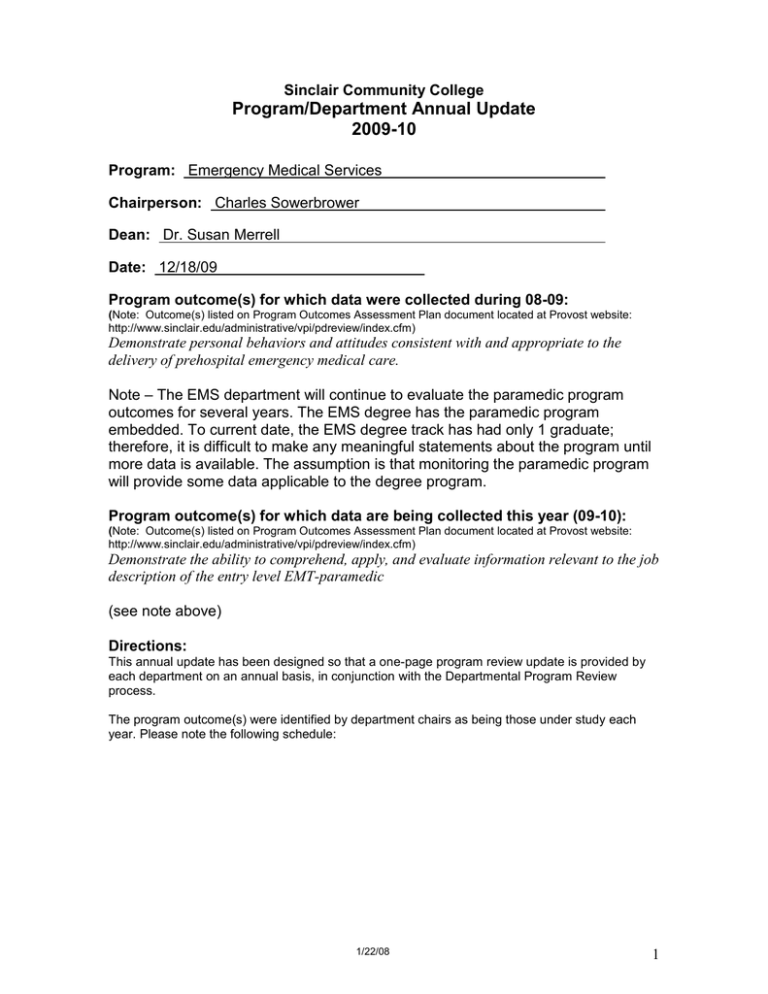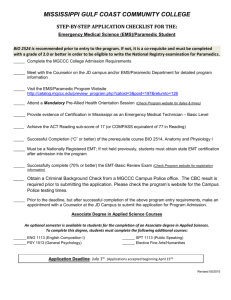Program/Department Annual Update 2009-10
advertisement

Sinclair Community College Program/Department Annual Update 2009-10 Program: Emergency Medical Services Chairperson: Charles Sowerbrower Dean: Dr. Susan Merrell Date: 12/18/09 Program outcome(s) for which data were collected during 08-09: (Note: Outcome(s) listed on Program Outcomes Assessment Plan document located at Provost website: http://www.sinclair.edu/administrative/vpi/pdreview/index.cfm) Demonstrate personal behaviors and attitudes consistent with and appropriate to the delivery of prehospital emergency medical care. Note – The EMS department will continue to evaluate the paramedic program outcomes for several years. The EMS degree has the paramedic program embedded. To current date, the EMS degree track has had only 1 graduate; therefore, it is difficult to make any meaningful statements about the program until more data is available. The assumption is that monitoring the paramedic program will provide some data applicable to the degree program. Program outcome(s) for which data are being collected this year (09-10): (Note: Outcome(s) listed on Program Outcomes Assessment Plan document located at Provost website: http://www.sinclair.edu/administrative/vpi/pdreview/index.cfm) Demonstrate the ability to comprehend, apply, and evaluate information relevant to the job description of the entry level EMT-paramedic (see note above) Directions: This annual update has been designed so that a one-page program review update is provided by each department on an annual basis, in conjunction with the Departmental Program Review process. The program outcome(s) were identified by department chairs as being those under study each year. Please note the following schedule: 1/22/08 1 Program Outcomes 06-07 07-08 08-09 Direct measure data are collected EMS 139 Direct measure data are analyzed Document improvements Direct measure data are collected EMS 139 Direct measure data are analyzed 09-10 10-11 PO #1 Demonstrate the ability to comprehend, apply, and evaluate information relevant to the job description of the entry level EMT-paramedic. PO #2 Demonstrate the ability to proficiently perform all procedures relevant to the job description of an entry-level EMTparamedic PO #3 Demonstrate personal behaviors and attitudes consistent with and appropriate to the delivery of prehospital emergency medical care. Direct measure data are collected EMS 139 PO #4 Document improvement s Direct measure data are analyzed Direct measure data are collected EMS 139 Demonstrate the ability to comprehend, apply, and evaluate information relevant to the job description of the entry level EMT-paramedic Document improvements Direct measure data are analyzed PO #5 Demonstrate the ability to proficiently perform all procedures relevant to the job description of an entry-level EMTparamedic Direct measure data are collected EMS 139 1/22/08 2 Please e-mail this completed form to angie.didier@sinclair.edu by December 18, 2009. Thank you. Please list noteworthy changes in the data set from last year: Pass rates paramedic program graduates for all of 2008: o First time pass rate = 78% (national = 66%) o Aggregate pass rate = 98% (national = 85%) Pass rates EMT-Basic program graduates for all of 2008: o First time pass rate = 86% (national = 65%) o Aggregate pass rate = 92% (national =79%) Enrollment Data Paramedic Enrollment 160 150 140 130 120 110 100 90 80 2000- 2001- 2002- 2003- 2004- 2005- 2006- 2007- 20082001 2002 2003 2004 2005 2006 2007 2008 2009 Paramedic enrollment analysis – consistent growth (38% in 9 yrs) EMT Basic Enrollment 450 400 350 300 250 200 150 2000- 2001- 2002- 2003- 2004- 2005- 2006- 2007- 20082001 2002 2003 2004 2005 2006 2007 2008 2009 EMT Basic enrollment analysis – Consistent growth with unparalleled growth within last 2 years (40% in 1 year) Program attrition rates. EMT-Basic average 9 year attrition rate is 39% (stable for last 2 years). Paramedic average attrition rate is 39% with a marked decline to 27% in 2008-2009. 1/22/08 3 Please list the actions and/or improvement priorities underway from the most recent program review recommendations: (Recommendations from department review conducted 2009) Continue to collect and analyze attrition/retention data to determine the effect of the mandatory attendance policy for paramedic students. If data supports, consider instituting the policy for EMT Basic students. Continue to investigate the potential benefits and problems that might be associated with on-line/hybrid course delivery of 200 level EMS courses. As the new associate’s degree program is implemented, monitor the demand and completion rates to determine the long term viability of the program. Because most of the employment opportunity for graduates of this program is with regional fire departments, the department should ensure it continues to maintain a close and effective working relationship with the leadership of area fire departments. The Emergency Medical Services program is highly effective and forward-looking with a strong continuous improvement focus. The department enjoys positive and effective relationships with area health care organizations in the region and is meeting the needs of the community for well-prepared emergency medical personnel. Realignment of academic divisions resulted in the Emergency Medical Services Department moving to the Business and Public Services Division. Although the department chair and faculty have been made to feel welcome in the new division, they express experiencing a loss of collaboration and sharing of ideas and resources with the departments in the Life and Health Sciences Division. Program outcome(s)--data collected in 07-08 What actions/improvements are underway as a result of your data analysis? Paramedic students are evaluated using several tools during EMS 139. The clinical component exit tool has been redesigned to evaluate general education outcomes. Effective 2009, all paramedic students are required to complete patient care reports which are evaluated by EMS department faculty. This ongoing effort is to improve documentation skills. Employer and graduate surveys will continue to be evaluated for relevance to this topic. Program outcome(s)--data collected in 08-09 How have you analyzed the data collected? What did you find? Describe the results obtained. Attrition rates within the paramedic program have improved after institution of required attendance. No negative outcomes of this new policy have been noted. Policy will continue and attrition will continue to 1/22/08 4 be tracked. The EMT-Basic program is operating with a required attendance policy in place. Pass rates for the EMS programs continue to remain above accreditation requirements and also above national averages. This data provides external validity to efforts of the department. The EMS degree has had one completer. To current date, there are over 260 students enrolled in either the EMSVS.AAS or EMSFO.AAS degree tracks. Many of these students are merely exploring the profession and/or need a degree designation for financial aid purposes. As the department moves to semesters, systems will be explored to clean the data set to more career committed students. Program outcome(s)—data collected for 09-10 For the outcome(s) currently under study (for 09-10 outcomes), what evidence and process do you plan to use to determine the extent to which this/these program outcome(s) have been met? Employer and graduate surveys will be reviewed related to documentation skills. Access to online development resources within the college is currently limited due to semester conversion. For the foreseeable future, EMS courses will have inadequate enrollment to justify college investment in the conversion to the online environment. EMS degree courses have been constructed with some degree of asynchronous delivery in mind. Redesign of all EMS curriculum is underway related to changes within the national curricula and the need to move courseware to semester system. Surveys of employers, graduates, advisory committee, and faculty are currently in the field. This information will be used to deconstruct and rebuild the curriculum from the ground up. All outcomes will be reevaluated to determine appropriateness. Note: Next year, you will be asked to describe the analysis (09-10 outcomes), and actions/improvements underway (08-09 outcomes). General Education Describe any general education changes/improvements in your program/department during this past academic year (08-09). Consistent comments from graduate and employer survey indicate a need to improve writing skills. Paramedics are required to process large amounts of data from very disparate sources and then distill same into a relevant document. (see 07/08 data above) 1/22/08 5


